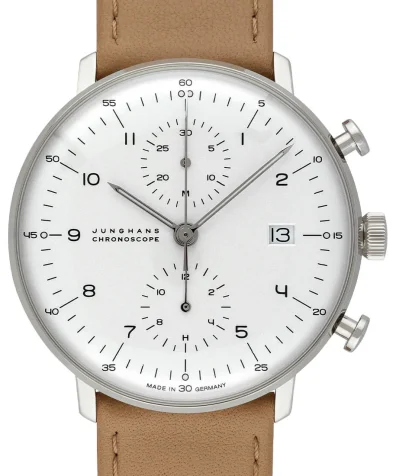 Junghans
Junghans
Junghans Max Bill
Junghans Max Bill
Max Bill and Junghans, now this was a historic collaboration. The ingenuity of this combination ended up resulting in an ageless timepiece. It’s one that has never been forced, out of necessity or as a part of a new marketing gag, to have to completely redefine itself. The demands that Junghans and its genius Max Bill placed upon themselves in the creation of such a successful watch were enormous. In the same vein, there’s probably a measure of truth that Max Bill probably peaked out in his very pursuit of finding design perfection. He also unknowingly (or perhaps knowingly, who can say with artists) ushered in an enthusiastic craze for his take on clean watch optics that still captivates people even today.
Its origins can be traced back to two simple designs: one with index lines and one with Arabic numbers. These models certainly didn’t blow the sales numbers doors off when they hit the market. In their early days, the watches were only infrequently sold and their production was ultimately halted just two years down the road. Max Bill’s influence on horology wasn’t a watershed moment, but more of a long term process that gained traction over a period of years. The watch itself has also grown richer in variety, right alongside the dimensions of its automatic model case sizes. Its greatest strength and a big part of its allure remains continuity. Next to all the heritage and retro models of yesteryear, its legacy has never been forgotten. It remains a promise of the love for artistic and enduring craftsmanship that has been kept well. Max Bill wouldn’t have it any other way.
Max Bill broken down into numbers – Top 5 Facts
200: Two hundred kilometres from Grenchen to Schramberg
The original Max Bill collection incorporated the manually winding movements of the J84/S3 and the J84/S10 as well as the automatic movement, the J83/E. Nowadays, the ETA 2824 is in action for the automatic model and the ETA 2801 for the hand winding movement. These are delivered to Junghans from Grenchen and have been designated as the J.800 and the J.805.
2: Two base designs
Many sources and databanks don’t share the same viewpoint when attempting to answer the question of whether or not some models should be directly attributed to Max Bill. This is also true of the pocket watch Astra, where only its varying fonts speak against a Max Bill identity. Only two base designs, reflected in 8 different model variations, leave no doubt as to their origins. Today, the collection has been expanded by both the Chronograph Chronoscope and some quartz based models. The original Max Bill designs are composed of black, gold, and silver (with or without sun-brushing).
3: A three figure Euro sum for a true watch classic
The Max Bill belongs to a group of watch models that are often cheaper when purchased brand new rather than used. This rings especially true for automatic models with a stainless steel case, as long as they are preserved in a good condition. Retail prices will eventually change in the future, due to the significant mechanical upgrade that Max Bill watches have undergone in the last few years. In the Max Bill collection, you’re getting a whole lot of value for only a three figure price tag. You usually have to spend a lot more cash to call another manufacturer’s icon your very own.
4: A turned over chair resembling a four
No other design element is so closely connected with the name of Max Bill then the inverted, tripod chair shaped, number four on the dial. Multiple models with Arabic numerals are fitted with this unique feature. However, this doesn’t necessarily mean that many Junghans watches are equipped with the famous Max Bill number four.
1,5: A year and a half long Bauhaus education
Max Bill only studied for a total of three semesters at Bauhaus in Dessau, Germany before he ended his degree program. Most likely because of a lack of personal finances. Since then, multiple models have been influenced by his time there and other German watch manufacturers have also produced these types of designs: notably the Stowa Antea and the Dugena Dessau. Today, Bauhaus designs have been given a fresh pulse from Nomos Glasshütte.
A Chronology of the Max Bill
1908: Max Bill is born in Winterthur, Switzerland.
1927: The Swiss artist commences his education at Bauhaus in Dessau.
1956: Max Bill and Junghans begin a joint cooperation and design an egg-like watch for a kitchen wall. It incorporated his typical dial design which was based on his wristwatch drafts.
1958: The Quadrat table watch is first created.
1961/1962: Max Bill designs some watch models for Junghans which go into production.
1963: Production grinds to a halt.
1994: Unexpectedly, Max Bill passes away while traveling through Tegel airport in Berlin.
1997: The Max Bill collection is re-launched and from this point forward, it is an important pillar in the entire product portfolio from Junghans.
2005: An automatic model is added to the collection. Just for comparisons sake, this new models case size has been increased to 38 Millimetres compared to the one from the 1960s.
2008: The first Max Bill chronograph, the Chronoscope, is launched. It isn’t an original design from Max Bill and should be considered as more of a tribute to him.
2011: A massive Max Bill Chronoscope in an extremely limited edition of 150 pieces is presented on the 150th anniversary of Junghans.
2015: The Max Bill collection brings out a few more watch types. There’s a new Chronoscope in dark grey complimented by a beige watch strap. For the ladies, there’s watch straps in brighter colours e.g. blue and red. There’s also even a Chronoscope available with a weekday display.

























































